
Camp David is the 125-acre (51 ha) country retreat for the President of the United States. It is located in the wooded hills of Catoctin Mountain Park, in Frederick County, Maryland, near the towns of Thurmont and Emmitsburg, about 62 miles (100 km) north-northwest of the national capital city of Washington, D.C. It is code named Naval Support Facility Thurmont. Technically a military installation, the staffing is primarily provided by the Seabees, Civil Engineer Corps (CEC), the United States Navy and the United States Marine Corps. Naval construction battalions are tasked with Camp David construction and send detachments as needed.

Sir John Major is a British former politician who served as Prime Minister of the United Kingdom from November 1990 to May 1997 and Leader of the Conservative Party from November 1990 to June 1997. He previously held Cabinet positions under prime minister Margaret Thatcher, lastly as Chancellor of the Exchequer from 1989 to 1990. Major was the Member of Parliament (MP) for Huntingdon, formerly Huntingdonshire, from 1979 to 2001. Since stepping down as an MP in 2001, Major has focused on writing and his business, sporting and charity work, and has occasionally commented on political developments in the role of an elder statesman.

The prime minister of the United Kingdom is the head of government of the United Kingdom. The prime minister advises the sovereign on the exercise of much of the royal prerogative, chairs the Cabinet and selects its ministers. As modern prime ministers hold office by virtue of their ability to command the confidence of the House of Commons, they sit as members of Parliament.

Downing Street is a street in Westminster in London that houses the official residences and offices of the Prime Minister of the United Kingdom and the Chancellor of the Exchequer. Situated off Whitehall, it is 200-metre (660 ft) long, and a few minutes' walk from the Houses of Parliament. Downing Street was built in the 1680s by Sir George Downing.
One-nation conservatism, also known as one-nationism or Tory democracy, is a paternalistic form of British political conservatism. It advocates the preservation of established institutions and traditional principles within a political democracy, in combination with social and economic programmes designed to benefit the ordinary person. According to this political philosophy, society should be allowed to develop in an organic way, rather than being engineered. It argues that members of society have obligations towards each other and particularly emphasises paternalism, meaning that those who are privileged and wealthy should pass on their benefits. It argues that this elite should work to reconcile the interests of all social classes, including labour and management, rather than identifying the good of society solely with the interests of the business class.
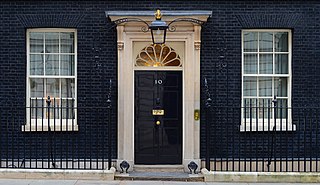
10 Downing Street in London is the official residence and office of the prime minister of the United Kingdom.

David William Donald Cameron is a British former politician who previously served as Prime Minister of the United Kingdom from 2010 to 2016 and Leader of the Conservative Party from 2005 to 2016. He previously served as Leader of the Opposition from 2005 to 2010, and was Member of Parliament (MP) for Witney from 2001 to 2016. He identifies as a one-nation conservative, and has been associated with both economically liberal and socially liberal policies.
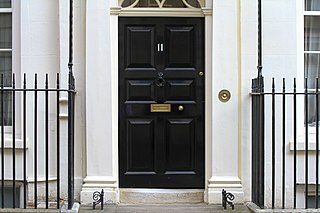
11 Downing Street in London, also known colloquially in the United Kingdom as Number 11, is the official residence of Britain's Chancellor of the Exchequer. The residence, in Downing Street in London, was built alongside the official residence of the Prime Minister at Number 10 in 1682.
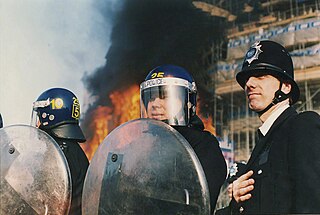
The poll tax riots were a series of riots in British towns and cities during protests against the Community Charge, introduced by the Conservative government of Prime Minister Margaret Thatcher. The largest protest occurred in central London on Saturday 31 March 1990, shortly before the tax was due to come into force in England and Wales.

Samantha Gwendoline Cameron is an English businesswoman. Until 13 May 2010, she was the creative director of Smythson of Bond Street. Her husband, David Cameron, was the British prime minister from 2010 to 2016. She took on a part-time consultancy role at Smythson after he became prime minister.

The office of Downing Street Chief of Staff is the most senior political appointee in the Office of the Prime Minister of the United Kingdom, acting as a senior aide to the Prime Minister of the United Kingdom. The holder of the office retains a highly powerful, non-ministerial position within His Majesty's Government.

Oliver Michael Robert Eden, 8th Baron Henley, 6th Baron Northington PC, is a British hereditary peer and politician, who is a Conservative member of the House of Lords. He has served in a number of ministerial positions in the governments of Margaret Thatcher, John Major, David Cameron and Theresa May, most recently as Parliamentary Under-Secretary of State at the Department for Business, Energy and Industrial Strategy.

The modern political history of the United Kingdom (1979–present) began when Margaret Thatcher gained power in 1979, giving rise to 18 years of Conservative government. Victory in the Falklands War (1982) and the government's strong opposition to trade unions helped lead the Conservative Party to another three terms in government. Thatcher initially pursued monetarist policies and went on to privatise many of Britain's nationalised companies such as British Telecom, British Gas Corporation, British Airways and British Steel Corporation. She kept the National Health Service. The controversial "poll tax" to fund local government was unpopular, and the Conservatives removed Thatcher as Prime Minister in 1990, although Michael Heseltine, the minister who did much to undermine her, did not personally benefit from her being ousted.

Chief Mouser to the Cabinet Office is the title of the official resident cat at 10 Downing Street, the residence and executive office of the prime minister of the United Kingdom in London. There has been a resident cat in the British government employed as a mouser and pet since the 16th century, although modern records date only to the 1920s. Despite other cats having served Downing Street, the first one to be given the official title of Chief Mouser by the British government was Larry in 2011. Other cats have been given this title affectionately, usually by the British press.
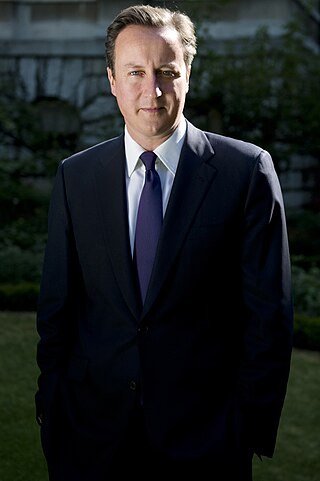
David Cameron's term as the Prime Minister of the United Kingdom began on 11 May 2010, when he accepted an invitation of Queen Elizabeth II to form a government, succeeding Gordon Brown of the Labour Party, and ended on 13 July 2016 upon his resignation following the 2016 referendum that favoured Brexit, which he had opposed. While serving as prime minister, Cameron also served as the first lord of the treasury, minister for the civil service and leader of the Conservative Party.
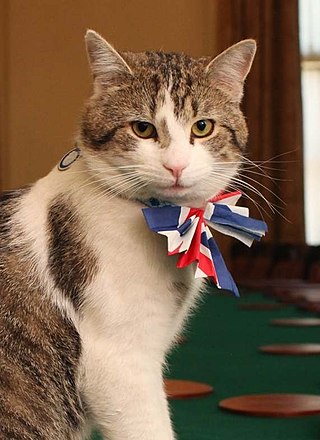
Larry is a British domestic tabby cat who has served as Chief Mouser to the Cabinet Office at 10 Downing Street since 2011. Larry is cared for by Downing Street staff and is not the personal property of the prime minister.
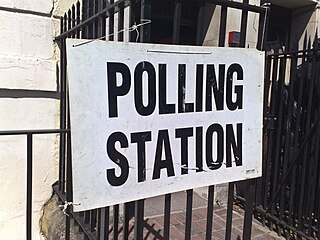
The events surrounding the formation of the United Kingdom's government in 2010 took place between 7 May and 12 May 2010, following the 2010 general election, which failed to produce an overall majority for either of the country's two main political parties. The election, held on 6 May, resulted in the first hung parliament in the UK in 36 years, sparking a series of negotiations which would form the first coalition government since the Second World War.

On 8 April 2013, former British prime minister Margaret Thatcher, Baroness Thatcher, died of a stroke at the Ritz Hotel, London, at the age of 87. On 17 April, she was honoured with a ceremonial funeral. Due to polarised opinions about her achievements and legacy, the reaction to her death was mixed across the UK, including contrasting praise, criticism, and celebration of her life and death.

Kenya–United Kingdom relations are bilateral relations between Kenya and the United Kingdom. The interactions between the two states have been positive and friendly since Kenya's independence in 1963. Both the UK and Kenya are members of the Commonwealth of Nations and engage with each other regularly on matters of military, economic and cultural importance. Kenya retains many aspects of British culture and governance, such as continuing to use English within administration, education and the law, driving on the left, hosting a diaspora community of Britons, and having a large Protestant population. The British military continues to play an important role in the country with Kenya hosting the UK's largest base in Africa, which provides vital anti-terrorism training to the Kenyan police. The British royal family, in particular the Queen had very close personal ties to the country. Elizabeth II was in Kenya when she received news that her father King George VI had died, and had made multiple state visits throughout her reign. To mark the 2022 Platinum Jubilee, Prince Edward visited the country to reinforce ties and celebrate Kenya's historic and current relationship with the UK. British tourism and finance are significant contributors to the Kenyan economy, with 100,000 British people visiting the country ever year for its national parks and wildlife.


















